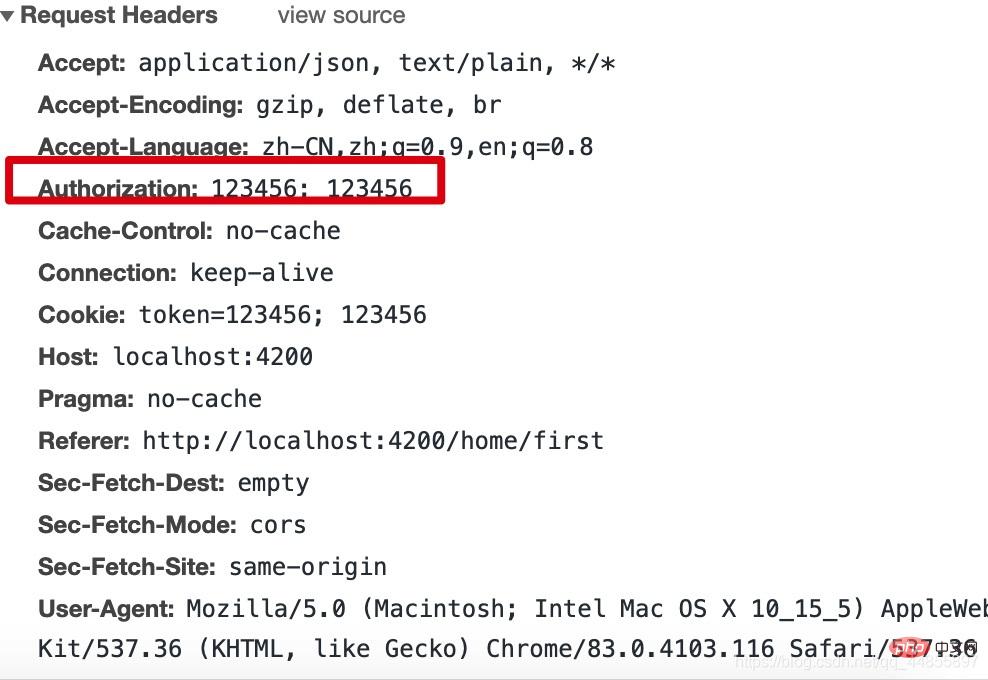
This article will talk with you about the use of interceptors in angular9. It has certain reference value. Friends in need can refer to it. I hope it will be helpful to everyone.

Related tutorial recommendations: "angular tutorial"
Interceptors uniformly add token
When we are building a backend management system, we need to add a token to the request header of each request, so let’s learn about angular’s interceptor and use
Interceptor usage
1. Create http.service.ts for network requests
import { Injectable } from '@angular/core';import { HttpClient } from '@angular/common/http';@Injectable({
providedIn: 'root'})export class HttpService {
constructor(private http: HttpClient) { }
getData () {
return this.http.get('/assets/mock/data.json')
}}2. Create noop.interceptor.ts, interceptor implementation code
import { Injectable } from '@angular/core';import {
HttpEvent, HttpInterceptor, HttpHandler, HttpRequest, HttpResponse} from '@angular/common/http';import { Observable } from 'rxjs';import { tap } from 'rxjs/operators';import { Router } from '@angular/router';/** Pass untouched request through to the next request handler. */@Injectable()export class NoopInterceptor implements HttpInterceptor {
constructor (private router: Router) {}
intercept(req: HttpRequest<any>, next: HttpHandler):
Observable<httpevent>> {
// 拦截请求,给请求头添加token
let url = req.url // 可以对url进行处理
let token = document.cookie && document.cookie.split("=")[1]
// 登录请求排除在外
// if (!url.includes('login')) {
req = req.clone({
url, // 处理后的url,再赋值给req
headers: req.headers.set('Authorization', token)//请求头统一添加token
})
// }
return next.handle(req).pipe(
tap(
event => {
if (event instanceof HttpResponse) {
console.log(event);
if (event.status >= 500) {
// 处理错误
}
}
},
error => {
// token过期 服务器错误等处理
// this.router.navigate(['/login']);
})
);
}}</httpevent></any>3. Use
3.1Introduce HttpClientModule## in app.module.ts
#3.2 Registration of HttpService3.3 Use of NoopInterceptor interceptorimport { HttpClientModule, HTTP_INTERCEPTORS } from '@angular/common/http';import { HttpService } from './auth/http.service';import { NoopInterceptor } from './auth/noop.interceptor';@NgModule({
imports: [
BrowserModule,
HttpClientModule,
AppRoutingModule ],
providers: [
HttpService,
{ provide: HTTP_INTERCEPTORS, useClass: NoopInterceptor, multi: true }
],
// ... 省略})The effect after the interceptor is implemented
 Interceptors are generally used together with routing guards.
Interceptors are generally used together with routing guards.
Programming Learning Course! !
The above is the detailed content of A brief discussion on the usage of interceptors in angular9. For more information, please follow other related articles on the PHP Chinese website!
 What is 2K resolution?
What is 2K resolution?
 How to delete blank pages in word without affecting other formats
How to delete blank pages in word without affecting other formats
 How to switch settings between Huawei dual systems
How to switch settings between Huawei dual systems
 Recommended order for learning c++ and c language
Recommended order for learning c++ and c language
 How to view stored procedures in MySQL
How to view stored procedures in MySQL
 What is a hidden element in jquery
What is a hidden element in jquery
 What software is flash?
What software is flash?
 what is vb program
what is vb program